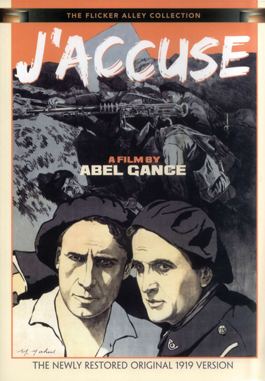home | metro silicon valley index | movies | current reviews | dvd review

J'Accuse
Two discs; Flicker Alley; $39.95
Reviewed by Michael S. Gant
On the heels of Abel Gance's La Roue, Flicker Alley, Lobster Films, Turner Entertainment Networks and the Nederlands Filmmuseum have collaborated on a beautifully restored version of Gance's original, 1919 antiwar epic J'Accuse (it was re-edited in the 1930s). These two sielnt-era marvels, brimming with technical innovations, show the artistic foundation that resulted in the extraordinary 1927 Napoleon, proving that Gance's reputation rests on more than that one masterpiece. Gance, who was in and out of the French army, filmed J'Accuse near the end of World War I, in 1918, although it was not released until 1919, after the Armistice. The story proceeds from an elemental love triangle to a scarifying revolt of the dead soldiers. Young Edith (Maryse Dauvray) is married to an older brutish man, François Laurin (Séverin-Mars), but really loves dreamy young Jean Diaz (Romuald Joubé), who writes pacifist verse. When war breaks out—as announced, chillingly, by some children who don't really know what the word means—Jean and François end up in the same unit. Foes at first, they begin to understand each other better in the trenches. Eventually, Jean, driven mad by the fighting, returns home and berates the villagers with his hallucinatory dream of a field of fallen soldiers rising up and marching on the living to deliver the film's searing charge: "J'accuse" ("I accuse," taken from Zola's famous exhortation on the Dreyfus affair). The battle scenes, full of colored smoke (the DVD restores Gance's extensive tinting), flames and explosions achieve both a documentary realism and a surrealistic fury, especially when Gance uses superimposed dancing skeletons as harbingers of wholesale slaughter. In one absurdist moment, we see a dead soldier buried up to his neck in trench mud, a bizarre grin frozen on his face. A very moving segment focuses on doomed soldiers before a big battle writing despairing farewell letters to their families—the close-ups are intercut with the text of actual letters. The power of the marching dead is enhanced by the knowledge that Gance used soldiers on leave, many of whom would not survive. Overall, J'Accuse certainly looks like a massive indictment of war (and most audiences of the time took it that way), although, as many critics have noted, it is hard to figure out exactly what Jean and Gance were really accusing. The dead soldiers' complaints seem directed as much at unfaithful wives and petty war profiteers as they do at the larger political context that creates war. The soldiers demand that their sacrifices not be in vain, but that could be construed as much a call for more sacrifice (witness the rhetoric about staying the course in Iraq) as a plea for peace. At the very end, Jean blames the sun itself for not caring about what happens on earth, which seems like a complete abdication of human agency. Perhaps Gance, who, as silent-film historian Kevin Brownlow has written, thought of cinema "not as a single art, but as a pantheon of all the arts," couldn't constrain his creative fervor to fashion a coherent message. What impresses us now, after nearly a century, isn't the antiwar thinking (World War II proved that the film failed in that mission) but the whole panoply of methods that Gance deploys: the masking and igniting of frames, the wide range of tinting, the poetic quotations in the intertitles, the insertion of painted images, the split screen (most trenchantly in a horizontal juxtaposition of the marching dead with a victory march through the Arc de Triomphe in Paris). It is as if, in the early days of the medium, Gance indulged an uncontrollable urge to try every technique he could think of in a riot of experimentation. They don't all work, but the film feels endlessly vital as a result. The DVD features a sympathetic score by Robert Israel and is accompanied by two World War I shorts and an essay by Brownlow.
Click Here to Talk About Movies at Metro's New Blog
Send a letter to the editor about this story.
|
|
|
|
|
|